最新智能型锂电池保护板电路的设计与实现
智能锂电池管理系统的设计与实现

智能锂电池管理系统的设计与实现随着科技的不断发展,锂电池作为一种绿色环保的能源储备方式越来越受到人们的青睐。
然而,锂电池的管理和维护一直是一个比较复杂的问题。
为了解决这个问题,智能锂电池管理系统应运而生。
本文旨在介绍智能锂电池管理系统的设计与实现,借助人工智能技术,实现对锂电池的智能管理和优化。
一、智能锂电池管理系统的背景随着新能源车辆的普及,锂电池的应用也越来越广泛。
然而,锂电池的管理和维护一直是一个比较复杂的问题。
针对这个问题,传统的方案是使用保护板进行管理,但是保护板的精度和可靠性并不高。
为了解决这个问题,智能锂电池管理系统应运而生。
它借助人工智能技术,可以实时地监测、分析和优化锂电池的状态,提高锂电池的效率和寿命。
二、智能锂电池管理系统的原理智能锂电池管理系统的核心是人工智能技术。
系统利用传感器对锂电池的电量、温度、压力等参数进行采集和监测,然后借助人工智能算法对这些数据进行分析和处理,最终输出优化后的控制指令,来实现对锂电池的智能管理。
具体来说,智能锂电池管理系统包含以下几个方面的技术:1. 数据采集技术智能锂电池管理系统需要对锂电池的电量、温度、压力、电流等参数进行采集。
目前,常用的传感器有电流传感器、温度传感器、压力传感器、电压传感器等。
2. 数据处理技术获取到锂电池的数据之后,需要进行处理和分析,以便更好地了解锂电池的状态和性能。
数据处理技术包括数据清洗、数据分析、数据建模等。
3. 人工智能算法人工智能算法是智能锂电池管理系统的核心。
根据锂电池的状态和性能,选择适当的算法进行分析和处理,比如神经网络、深度学习等。
4. 控制指令输出技术智能锂电池管理系统最终需要输出控制指令,来实现对锂电池的智能管理。
控制指令可以通过无线电信号或者有线方式传输到锂电池中,从而对其进行控制。
三、智能锂电池管理系统的优势智能锂电池管理系统相对于传统的锂电池管理方案具有以下优势:1. 提高锂电池的效率和寿命智能锂电池管理系统能够实时地监测、分析和优化锂电池的状态,有效地提高了锂电池的效率和寿命。
锂电池保护板二极保护电路设计

锂电池保护板二极保护电路设计锂电池是一种被广泛应用于电子产品中的电池,它具有高能量密度、轻量化以及长寿命的特点,因此受到了广泛的关注和应用。
然而,锂电池在充放电过程中存在着一定的安全隐患,如果不加以合理的保护措施,可能会导致电池过充、过放、短路等问题,甚至引发火灾或爆炸。
锂电池保护板的设计对于保障电池的安全性至关重要。
在锂电池保护板中,二极保护电路是一项至关重要的设计,它主要负责监测电池的电压、温度和电流等参数,一旦发现异常情况,及时对电池进行保护。
二极保护电路的设计对于确保锂电池的安全性至关重要。
本文将从设计原理、电路结构、工作原理和实际应用等方面对锂电池保护板二极保护电路进行深入探讨,以期为锂电池保护板的设计和应用提供一定的参考价值。
一、设计原理二极保护电路的设计原理主要是基于对锂电池充放电过程的监测和保护。
一般来说,锂电池的充放电过程中会伴随着电压、温度和电流等参数的变化,如果这些参数超出了锂电池的允许范围,就会对电池造成潜在的安全隐患。
二极保护电路的设计目标就是及时监测这些参数,并在出现异常情况时对电池进行保护,保证电池的安全性。
二、电路结构二极保护电路通常由电压检测电路、温度检测电路和电流检测电路等部分组成。
其中,电压检测电路一般采用分压电路来对电池的电压进行监测,温度检测电路则通常采用NTC热敏电阻来监测电池的温度变化,而电流检测电路则使用霍尔元件或电流互感器等来监测电池的充放电电流。
在监测到异常情况时,二极保护电路会通过MOS管或继电器等元件对电池进行保护,比如切断充电或放电电路,从而保证锂电池的安全性。
三、工作原理二极保护电路在工作过程中主要分为两个阶段,第一阶段是监测阶段,通过电压、温度和电流检测电路对电池的参数进行实时监测。
第二阶段是保护阶段,当监测到电池出现异常情况时,二极保护电路会通过控制MOS管或继电器等元件对电池进行保护,比如切断充电或放电电路,避免电池受到进一步的损害。
锂电池保护板的电路图与工作原理

锂电池保护板的电路图与工作原理锂电池保护板的电路图与工作原理关于锂离子电池的保护板电路,原理介绍,以及管理的书籍推荐.或者聚合物锂电池方面经典书籍。
太深奥了,建议新华书店锂电池保护板原理:锂电池保护板根据使用IC,电压等的不同而电路及参数有所不同。
锂电池保护板其正常工作过程为:当电池电压在2.5V至4.3V之间时,DW01 的第1脚、第3脚均输出高电平(等于供电电压),第二脚电压为0V。
此时DW01的第1脚、第3脚电压将分别加到8205A的第5 4脚,8205A内的两个电子开关因其G极接到来自DW01 的电压,故均处于导通状态,即两个电子开关均处于开状态。
此时电池的负极与保护板的P-端相当于直接连通,保护板有电压输出。
锂电池保护板的电路图与工作原理:锂电池保护板原理:锂电池保护板根据使用IC,电压等的不同而电路及参数有所不同。
锂电池保护板其正常工作...锂电池保护电路板生产过程中CC offset是什么意思?具体有什么作用!:保护板是有计算电芯容量的芯片吧? CC offset 估计是恒流补尝.(也就是在生产过程中通过负载放...求锂电池保护板原理图:照这个做吧!成熟的电路!改变R61可以改变充电电流的大小!有啥不懂进群讨论!105888932为什么有的锂电保护板需要激活?什么原理:所有的锂电池保护板在保护后都需要激活。
激活的方法很简单,在专用充电器上充电1-2分钟就可以了。
锂电池...18650 单节电池充放电保护电路原理图啊:工作原理:将充电器与手机、插座连接后,电压通过电阻调整,以一较小值进入电压比较器,输出一个额定值,是...如何制作18650锂电池保护板,要完整的原理图、pcb板图,:锂电保护板,多节,18650,原理图,PCB板,单片机程序,应有尽有!电池保护电路板都是什么够成的?上面好多小件:因为Li+电池过充或过放可能会导致爆炸并造成人员伤害,所以使用这类电池时,安全是主要关心的问题。
锂电池保护板设计与测试实验报告

锂电池保护板设计与测试实验报告综合实验题目:锂电池保护板设计与测试锂电池保护板设计与测试【摘要】购买3串(3个18650电池或聚合物锂电池串联组合)的锂电池保护板,型号HX-3S-01通过Altiumdesigner绘制电路原理图和PCB原理图,再在室温下通过模拟充放电过程测试保护板过充、过放范围及保护性能,测试结果表明在各电池电压低于 2.35V时电池处于过放状态,在各电池电压高于4.IV时电池处于过充状态。
锂电池保护版性能良好。
1.引言1.1锂电池保护板的由来锂电池(可充型)之所以需要保护,是由它本身特性决定的。
由于锂电池本身的材料决定了它不能被过充、过放、过流、短路及超高温充放电,因此锂电池锂电组件总会跟着一块精致的保护板和一片电流保险器出现。
锂电池的保护功能通常由保护电路板和PTC等电流器件协同完成,保护板是由电子电路组成,在-40℃至+85C的环境下时刻准确的监视电芯的电压和充放回路的电流,及时控制电流回路的通断;PTC在高温环境下防止电池发生恶劣的损坏。
1.2保护板的组成及元器件简介保护板通常包括控制IC、MOS开关、电阻、电容及辅助器件FUSE、PTC、NTC、ID、存储器等。
其中控制IC,在一切正常的情况下控制M0S开关导通,使电芯与外电路导通,而当电芯电压或回路电流超过规定值时,它立刻控制M0S开关关断,保护电芯的安全。
①、电阻:起限流、采样作用;②、电容:对直流电而言电阻值“8“,对交流电而言阻值接近零,电容两端电压不能突变,能起瞬间稳压作用,滤波作用;③、FUSE:熔断保险丝,起过流保护作用;④、PTC:PTC是Positivetemperaturecoefficient的缩写,意即正温度系数电阻,(温度越高,阻值越大),可以防止电池高温放电和不安全的大电流的发生,即过流保护作用。
⑤、NTC:是Negativetemperaturecoefficient的缩写,意即负温度系数,在环境温度升高时,其阻值降低,使用电设备或充电设备及时反应、控制内部中断而停止充放电。
锂电池保护板原理

锂电池保护板原理
锂电池保护板是一种电子控制装置,主要用于保护锂电池免受过充、过放、过流和短路等故障的影响,以延长锂电池的使用寿命和确保电池的安全性能。
锂电池保护板采用了一种基于微处理器或专用集成电路的智能控制技术来实现对锂电池的保护和管理。
其工作原理如下:
1. 过充保护:当锂电池充电至预设的充电终止电压时,保护板会自动切断电池与充电器之间的连接,停止充电,以防止电池过充,避免对电池造成损害。
2. 过放保护:当锂电池的电压降至预设的放电终止电压时,保护板会自动切断电池与负载之间的连接,停止放电,以避免电池过放而损坏。
3. 过流保护:当电池充电或放电过程中出现过大的电流时,保护板会立即切断电池与外部电路之间的连接,以防止电池过热、发生短路或其他故障。
4. 温度保护:保护板内置有温度传感器,当电池温度超过安全范围时,保护板会采取相应的措施,如减小充电电流或停止充放电,以防止电池过热引发安全事故。
5. 平衡充电:对于多个串联的锂电池组,保护板可以监测各个电池的电压,并在充电时自动进行均衡充电,确保各个电池之间的电压差异不会过大,以提高电池组的整体性能和寿命。
锂电池保护板的使用可以有效保护锂电池的安全性和使用寿命,防止因电池故障引发火灾、爆炸等危险情况的发生。
因此,在锂电池应用中,使用保护板是非常重要和必要的措施之一。
锂电池保护电路设计方案

锂电池保护电路设计方案锂电池材料构成及性能探析首先我们来了解一下锂电池的材料构成,锂离子电池的性能主要取决于所用电池内部材料的结构和性能。
这些电池内部材料包括负极材料、电解质、隔膜和正极材料等。
其中正、负极材料的选择和质量直接决定锂离子电池的性能与价格。
因此廉价、高性能的正、负极材料的研究一直是锂离子电池行业发展的重点。
负极材料一般选用碳材料,目前的发展比较成熟。
而正极材料的开发已经成为制约锂离子电池性能进一步提高、价格进一步降低的重要因素。
在目前的商业化生产的锂离子电池中,正极材料的成本大约占整个电池成本的40%左右,正极材料价格的降低直接决定着锂离子电池价格的降低。
对锂离子动力电池尤其如此。
比如一块手机用的小型锂离子电池大约只需要5克左右的正极材料,而驱动一辆公共汽车用的锂离子动力电池可能需要高达500千克的正极材料。
尽管从理论上能够用作锂离子电池正极材料种类很多,常见的正极材料主要成分为LiCoO2,充电时,加在电池两极的电势迫使正极的化合物释出锂离子,嵌入负极分子排列呈片层结构的碳中。
放电时,锂离子则从片层结构的碳中析出,重新和正极的化合物结合。
锂离子的移动产生了电流。
这就是锂电池工作的原理。
锂电池充放电管理设计锂电池充电时,加在电池两极的电势迫使正极的化合物释出锂离子,嵌入负极分子排列呈片层结构的碳中。
放电时,锂离子则从片层结构的碳中析出,重新和正极的化合物结合。
锂离子的移动产生了电流。
原理虽然很简单,然而在实际的工业生产中,需要考虑的实际问题要多得多:正极的材料需要添加剂来保持多次充放的活性,负极的材料需要在分子结构级去设计以容纳更多的锂离子;填充在正负极之间的电解液,除了保持稳定,还需要具有良好导电性,减小电池内阻。
虽然锂离子电池有以上所说的种种优点,但它对保护电路的要求比较高,在使用过程中应严格避免出现过充电、过放电现象,放电电流也不宜过大,一般而言,放电速率不应大于0.2C。
锂电池的充电过程如图所示。
锂电池保护板电路原理详解
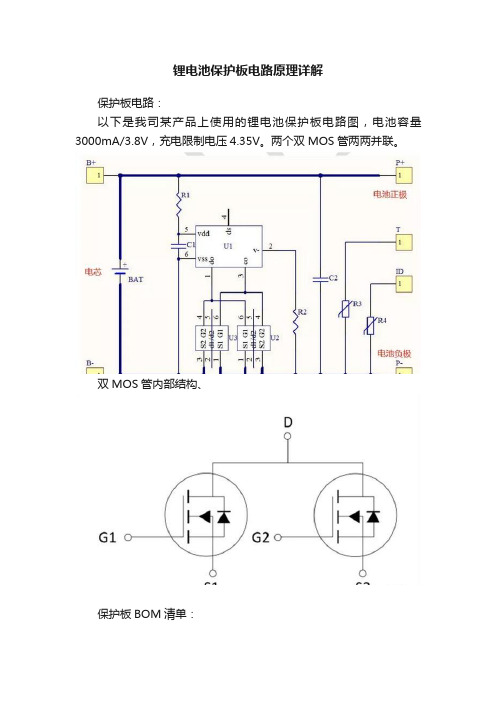
锂电池保护板电路原理详解
保护板电路:
以下是我司某产品上使用的锂电池保护板电路图,电池容量3000mA/3.8V,充电限制电压4.35V。
两个双MOS管两两并联。
双MOS管内部结构、
保护板BOM清单:
过充保护:
以上是电池充电电流流向,可见两个双MOS管(U2、U3)全部导通,充电的时候U1的Pin5芯片会实时监听电芯正极电压,此电压相对Pin6,因为Pin6是U1的地参考。
当电芯正极相对Pin6大于过充门限电压时,Pin3控制关闭两个MOS管,此时停止充电,只能放电。
当放电到过充恢复电压以下时,Pin3控制的MOS 管重新打开,
这时可以充电。
过放保护:
以上是电池放电电流流向,可见两个双MOS管(U2、U3)全部导通,放电的时候U1的Pin5芯片会实时监听电芯正极电压,此电压相对Pin6,因为Pin6是U1的地参考。
当电芯正极相对Pin6小于过放门限电压时,Pin1控制关闭两个MOS管,此时停止放电,只能充电。
当充电到过放恢复电压以上时,Pin1控制的MOS 管重新打开,这时可以放电。
放电过流/短路保护:
以上是电池放电电流流向,可见两个双MOS管(U2、U3)全部导通,放电的时候U1的Pin2芯片会实时监听电压,此电压相对Pin6,因为Pin6是U1的地参考。
实际上这个电压就是两个MOS的导通压降,电流越大压降越大,当电压大于放电过流保护/短路保护电压时,Pin1管脚关闭两个MOS管。
以下是芯片MM3280JB7NRH的各种截止电压参数:。
锂电池充电保护板电路

说明:图中另有电阻R3 ,一脚接CEG8205第二和第三脚,一脚接电池输出温度检测脚。
RI标有101字样R2标有102字样R3标有103字样
如果电池更换保护板或电芯后,输出电压归零,可以用非自动识别的万能充激活时间2分钟就行了。
电芯坏的表现是:用万能充直接充电芯充不进, 接万能充后不接电源,电芯电压逐渐降低,直到低于1伏.
电池保护板的代用:如果确定保护板坏了, 不想研究保护板电路图又无同样保护板可换,可以先把坏保护板上的元件全部拆除, 再找一个确定好的保护板,输入脚接电芯正负极,输出脚分别飞线接坏保护板的正负极和温度检测脚 .OK
图片:
图片:。
智能型锂电池管理系统(BMS)

智能型锂电池管理系统(BMS)产品简介【系统功能与技术参数】晖谱智能型电池管理系统(BMS),用于检测所有电池的电压、电池的环境温度、电池组总电流、电池的无损均衡控制、充电机的管理及各种告警信息的输出。
特性功能如下:1.自主研发的电池主动无损均衡专利技术电池主动无损均衡模块与每个单体电芯之间均有连线,任何工作或静止状态均在对电池组进行主动均衡。
均衡方式是通过一个均衡电源对单只电芯进行补充电,当某串联电池组中某一只单体电芯出现不平衡时对其进行单独充电,充电电流可达到5A,使其电压保持和其它电芯一致,从而弥补了电芯的不一致性缺陷,延长了电池组的使用时间和电芯的使用寿命,使电池组的能源利用率达到最优化。
2.模块化设计整个系统采用了完全的模块化设计,每个模块管理16只电池和1路温度,且与主控制器间通过RS485进行连接。
每个模块管理的电池数量可以从1~N(N≤16)只灵活设置,接线方式采用N+1根;温度可根据需要设置成有或无。
3.触摸屏显示终端中央主控制器与显示终端模块共同构成了控制与人机交互系统。
显示终端使了带触摸按键的超大真彩色LCD屏,包括中文和英文两种操作菜单。
实时显示和查看电池总电压、电池总电流、储备能量、单体电池最高电压、单体电池最低电压、电池组最高温度,电池工作的环境温度,均衡状态等。
4.报警功能具有单只电芯低电压和总电池组低电压报警延时功能,客户可以根据自己的需求,在显示界面中选择0S~20S间的任意时间报警或亮灯。
5.完善的告警处理机制在任何界面下告警信息都能以弹出式进行滚动显示。
同时,还可以进入告警信息查询界面进行详细查询处理。
6.管理系统的设置电池电压上限、下限报警设置,温度上限报警设置,电流上限报警设置,电压互差最大上限报警设置,SOC初始值设置,额定容量,电池自放电系数、充电机控制等。
7.超大的历史数据信息保存空间自动按时间保存系统中出现的各类告警信息,包括电池的均衡记录。
8.外接信息输出系统对外提供工业的CANBUS和RS485接口,同时向外提供各类告警信息的开关信号输出。
浅析锂电池保护板(BMS)系统设计思路(一)
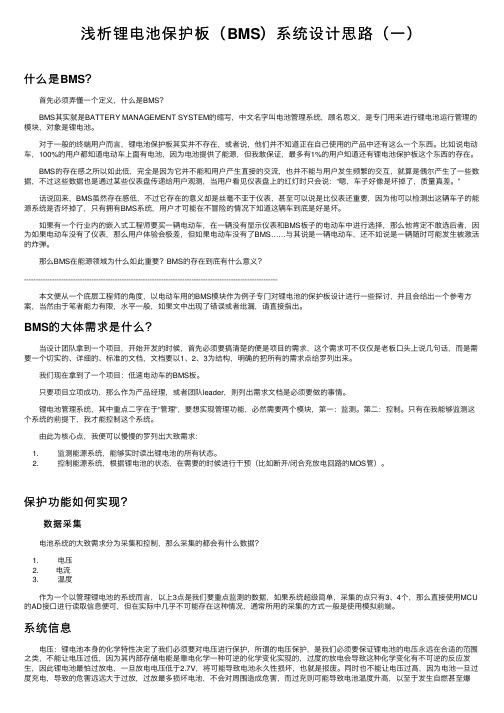
浅析锂电池保护板(BMS)系统设计思路(⼀)什么是BMS? ⾸先必须弄懂⼀个定义,什么是BMS? BMS其实就是BATTERY MANAGEMENT SYSTEM的缩写,中⽂名字叫电池管理系统,顾名思义,是专门⽤来进⾏锂电池运⾏管理的模块,对象是锂电池。
对于⼀般的终端⽤户⽽⾔,锂电池保护板其实并不存在,或者说,他们并不知道正在⾃⼰使⽤的产品中还有这么⼀个东西。
⽐如说电动车,100%的⽤户都知道电动车上⾯有电池,因为电池提供了能源,但我敢保证,最多有1%的⽤户知道还有锂电池保护板这个东西的存在。
BMS的存在感之所以如此低,完全是因为它并不能和⽤户产⽣直接的交流,也并不能与⽤户发⽣频繁的交互,就算是偶尔产⽣了⼀些数据,不过这些数据也是通过某些仪表盘传递给⽤户观测,当⽤户看见仪表盘上的红灯时只会说:“嗯,车⼦好像是坏掉了,质量真差。
” 话说回来,BMS虽然存在感低,不过它存在的意义却是丝毫不亚于仪表,甚⾄可以说是⽐仪表还重要,因为他可以检测出这辆车⼦的能源系统是否坏掉了,只有拥有BMS系统,⽤户才可能在不冒险的情况下知道这辆车到底是好是坏。
如果有⼀个⾏业内的嵌⼊式⼯程师要买⼀辆电动车,在⼀辆没有显⽰仪表和BMS板⼦的电动车中进⾏选择,那么他肯定不敢选后者,因为如果电动车没有了仪表,那么⽤户体验会极差,但如果电动车没有了BMS……与其说是⼀辆电动车,还不如说是⼀辆随时可能发⽣被激活的炸弹。
那么BMS在能源领域为什么如此重要?BMS的存在到底有什么意义?------------------------------------------------------------------------------------------------------------- 本⽂便从⼀个底层⼯程师的⾓度,以电动车⽤的BMS模块作为例⼦专门对锂电池的保护板设计进⾏⼀些探讨,并且会给出⼀个参考⽅案,当然由于笔者能⼒有限,⽔平⼀般,如果⽂中出现了错误或者纰漏,请直接指出。
【最新】锂电池保护电路

【最新】锂电池保护电路锂电池是怎么保护电路和功能离子电池保护电路包括过度充电保护、过电流/短路保护和过放电保护,要求过充电保护高精度、保护IC功耗低、高耐压以及零伏可充电等特性.详细介绍了这三种保护电路的原理、新功能和特性要求.锂电池具有体积小、能量密度高、无记忆效应、循环寿命高、高电压电池和自放电率低等优点,与镍镉、镍氢电池不太一样,锂电池必须考虑充电、放电时的安全性,以防止特性劣化.针对锂电池的过充、过度放电、过电流及短路保护很重要,所以通常都会在电池包内设计保护线路用以保护锂电池.由于锂离子电池能量密度高,因此难以确保电池的安全性.在过度充电状态下,电池温度上升后能量将过剩,于是电解液分解而产生气体,因内压上升而发生自燃或破裂的危险;反之,在过度放电状态下,电解液因分解导致电池特性及耐久性劣化,从而降低可充电次数.锂离子电池的保护电路就是要确保这样的过度充电及放电状态时的安全性,并防止特性劣化.锂离子电池的保护电路是由保护IC及两颗功率 MOSFET所构成,其中保护IC监视电池电压,当有过度充电及放电状态时切换到以外挂的功率MOSFET来保护电池,保护IC的功能有过度充电保护、过度放电保护和过电流/短路保护.过度充电保护过度充电保护IC的原理为:当外部充电器对锂电池充电时,为防止因温度上升所导致的内压上升,需终止充电状态.此时,保护IC需检测电池电压,当到达4.25V时(假设电池过充点为4.25V)即激活过度充电保护,将功率MOS由开转为关断,进而截止充电.另外, 还必须注意因噪声所产生的过度充电检出误动作,以免判定为过充保护.因此,需要设定延迟时间,并且延迟时间不能短于噪声的持续时间.过度放电保护在过度放电的情况下,电解液因分解而导致电池特性劣化,并造成充电次数的降低.采用锂电池保护IC可以避免过度放电现象发生,实现电池保护功能.过度放电保护IC原理:为了防止锂电池的过度放电状态,假设锂电池接上负载,当锂电池电压低于其过度放电电压检测点(假定为 2.3V)时将激活过度放电保护,使功率MOSFET由开转变为关断而截止放电,以避免电池过度放电现象发生,并将电池保持在低静态电流的待机模式,此时的电流仅 0.1uA.当锂电池接上充电器,且此时锂电池电压高于过度放电电压时,过度放电保护功能方可解除.另外,考虑到脉冲放电的情况,过放电检测电路设有延迟时间以避免发生误动作.过电流及短路电流因为不明原因(放电时或正负极遭金属物误触)造成过电流或短路,为确保安全,必须使其立即停止放电.过电流保护IC原理为,当放电电流过大或短路情况发生时,保护IC将激活过(短路)电流保护,此时过电流的检测是将功率MOSFET的 Rds(on)当成感应阻抗用以监测其电压的下降情形,如果比所定的过电流检测电压还高则停止放电,计算公式为: V-=I_Rds(on)_2(V-为过电流检测电压,I为放电电流).假设V-=0.2V,Rds(on)=25mΩ,则保护电流的大小为I=4A.同样地,过电流检测也必须设有延迟时间以防有突发电流流入时发生误动作.通常在过电流发生后,若能去除过电流因素(例如马上与负载脱离),将会恢复其正常状态,可以再进行正常的充放电动作.锂电池保护IC的新功能除了上述的锂电池保护IC功能之外,下面这些新的功能同样值得关注:1. 充电时的过电流保护当连接充电器进行充电时突然发生过电流(如充电器损坏),电路立即进行过电流检测,此时Cout将由高转为低,功率MOSFET由开转为关断,实现保护功能.V-(Vdet4过电流检测电压,Vdet4为-0.1V)=I(充电电流)_Rds(on)_22. 过度充电时的锁定模式通常保护IC在过度充电保护时将经过一段延迟时间,然后就会将功率MOSFET关断以达到保护的目的,当锂电池电压一直下降到解除点(过度充电滞后电压)时就会恢复,此时又会继续充电-保护-放电-充电-放电.这种状态的安全性问题将无法获得有效解决,锂电池将一直重复着充电-放电-充电-放电的动作,功率MOSFET的栅极将反复地处于高低电压交替状态,这样可能会使MOSFET变热,还会降低电池寿命,因此锁定模式很重要.假如锂电保护电路在检测到过度充电保护时有锁定模式,MOSFET将不会变热,且安全性相对提高很多.在过度充电保护之后,只要充电器连接在电池包上,此时将进入过充锁定模式.此时,即使锂电池电压下降也不会发生再充电的情形,将充电器移除并连接负载即可恢复充放电的状态.3. 减小保护电路组件尺寸将过度充电和短路保护用的延迟电容集成到到保护IC里面,以减小保护电路组件尺寸.对保护IC性能的要求1. 过度充电保护的高精度化当锂离子电池有过度充电状态时,为防止因温度上升所导致的内压上升,须截止充电状态.保护IC将检测电池电压,当检测到过度充电时,则过度充电检测的功率MOSFET使之关断而截止充电.此时应注意的是过度充电的检测电压的高精度化,在电池充电时,使电池充电到饱满的状态是使用者很关心的问题, 同时兼顾到安全性问题,因此需要在达到容许电压时截止充电状态.要同时符合这两个条件,必须有高精度的检测器,目前检测器的精度为25mV,该精度将有待于进一步提高.2. 降低保护IC的耗电随着使用时间的增加,已充过电的锂离子电池电压会逐渐降低,最后低到规格标准值以下,此时就需要再度充电.若未充电而继续使用,可能造成由于过度放电而使电池不能继续使用.为防止过度放电,保护IC必须检测电池电压,一旦达到过度放电检测电压以下,就得使放电一方的功率MOSFET 关断而截止放电.但此时电池本身仍有自然放电及保护IC的消耗电流存在,因此需要使保护IC消耗的电流降到最低程度.3. 过电流/短路保护需有低检测电压及高精度的要求因不明原因导致短路时必须立即停止放电.过电流的检测是以功率MOSFET 的Rds(on)为感应阻抗,以监视其电压的下降,此时的电压若比过电流检测电压还高时即停止放电.为了使功率MOSFET的Rds(on)在充电电流与放电电流时有效应用,需使该阻抗值尽量低,目前该阻抗约为 20mΩ_30mΩ,这样过电流检测电压就可较低.4. 耐高电压电池包与充电器连接时瞬间会有高压产生,因此保护IC应满足耐高压的要求.5. 低电池功耗在保护状态时,其静态耗电流必须要小0.1uA.6. 零伏可充电有些电池在存放的过程中可能因为放太久或不正常的原因导致电压低到0V,故保护IC需要在0V时也可以实现充电.保护IC发展展望如前所述,未来保护IC将进一步提高检测电压的精度、降低保护IC的耗电流和提高误动作防止功能等,同时充电器连接端子的高耐压也是研发的重点.在封装方面,目前已由SOT23-6逐渐转向SON6封装,将来还有CSP封装,甚至出现COB产品用以满足现在所强调的轻薄短小要求.在功能方面,保护IC不需要集成所有的功能,可根据不同的锂电池材料开发出单一保护IC,如只有过充保护或过放保护功能,这样可以大大减少成本及尺寸.当然,功能组件单晶体化是不变的目标,如目前手机制造商都朝向将保护IC、充电电路以及电源管理IC等外围电路与逻辑IC构成双芯片的芯片组, 但目前要使功率MOSFET的开路阻抗降低,难以与其它IC集成,即使以特殊技术制成单芯片,恐怕成本将会过高.因此,保护IC的单晶体化将需一段时间来解决.锂电池保护板的电路图与工作原理关于锂离子电池的保护板电路,原理介绍,以及管理的书籍推荐.或者聚合物锂电池方面经典书籍。
智能锂电池保护电路板方案
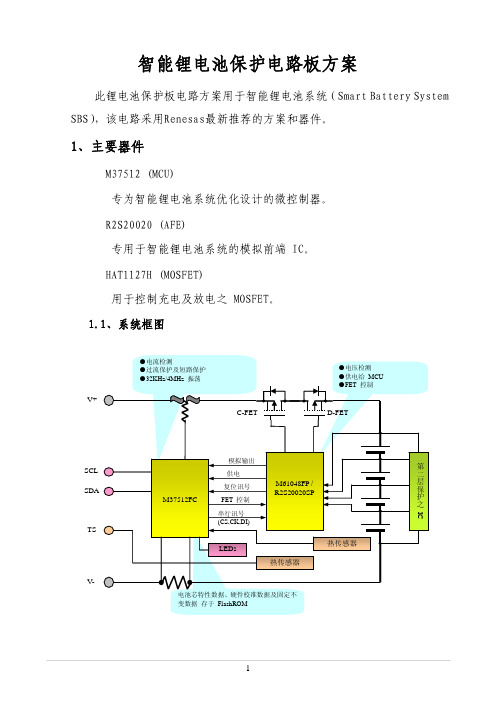
●电流检测 ●过流保护及短路保护 ●32KHz/4MHz 振荡
V+ C-FET
●电压检测 ●供电给 MCU ●FET 控制
D-FET
IC
模拟输出
第
SCL
供电
二 层
SDA
M37512FC
复位讯号 FET 控制
M61048FP / R2S20020SP
保 护 之
串行讯号
(CS,CK,DI)
TS
LEDs
热传感器
1.3、 R2S20020 功能概述 z 配合 MCU 的模拟前端 IC 调整器输出 2.5V。 输出复位讯号(2.0V 复位,2.2V 释放)。 相比 M61048,增加了新功能。 z 检测电池芯电压 内置放大器之电压增益:0.43 ±1%。 z 供电给 LED 供 3.3V 给 LED 显示。 z 检测电池芯抽头的联接 可避免因电池芯抽头之联结失误而引起的危险。 z 监测电池盒正极的联接 可测知是否接上充电器。
初始校准资料。 电池芯特性数据。 固定不变的 SMBus 数据(序列号,制造商名称 等)。 安全控制的数据。 等等。 z 重新获知的数据存于 DataFlash 电量余量。 满充电余量。 电池模式。 等等。
2.3、软件的功能
z 电量余量的控制 以电流积分 检测 充电或放电。 以电流积分 计算 电量余量。
-2-
2、嵌入式系统软件
该软件配合此电路方案用于智能锂电池系统。 2.1、特性
即使无软件编写、使用的经验,也可以很容易使用该软件 降低客户之研发成本 缩短客户之研发周期 符合 Smart Battery Data Spec 的 1.1a 版 多项设置以保障高精度和高安全性 2.2、资料设置 z 所有客户化数据都存储于 FlashROM
锂电池保护板设计.docx

字体大小:?????锂离子电池保护板设计锂离子电池保护器IC有适用于单节的及2~4节电池组的.这里介绍这类保护器的要求,并重点介绍单节锂离子电池保护器电路.对锂离子电池保护器的基本要求:1.充电时要充满,终止充电电压精度要保护±1%; 2.在充、放电过程中不过流,并有短路保护;3.到达终止放电电压要禁止继续放电,终止放电电压精度在±3%左右;4.对深度放电的电池(低于终止放电电压)在充电前以涓流方式预充电; 5.为了工作稳定可靠,防止瞬态电压变化的干扰,内部有过充电、过放电、过流保护的延时电路,防止瞬态干扰造成误动作;6.在多个串联的电池组充电时,要保护各节电池电压的匹配平衡,匹配精度要求±10%左右;7.自身耗电省(无论在充、放电时保护器都是通电工作的).单节电池保护器耗电一般小于10μA,多节的一般在20μA左右;在到达终止放电时,它处于关闭状态,一般耗电2μA以下;8.保护器电路简单,外围元器件少,占空间小,可以做在电池或电池组中.富精单节锂离子电池保护器DW01这里以富精单节锂离子电池保护器DW01为例来说明保护器的电路及工作原理.该器件主要特点:终止充电电压有4.35V、4.30V及4.25V(分别由型号后缀A、B、C表示),充电电压精度可达±30mV(±0.7%);耗电省,在3.5V工作电压时工作电流典型值7μA,到达终止放电后耗电仅0.2μA;有过充、过放、过流保护,并有延时以免瞬态干扰;过放电电压2.4V,精度±3.5%;小尺寸5管脚SOT-23封装;工作温度范围-20~+80℃. DW01组成的单节锂离子电池保护电路上图,其内部结构简化图及外部元器件图如下图所示.V1为控制放电的MOSFET,V2为控制充电的MOSFET,R1、C1用来消除充电器输入电压的纹波及干扰电压,R2为防止充电器电源接反时保护CS端的电阻,R3为V2的偏置电阻,FU为保险丝,BATT+及BATT-为电池组的正极和负极(此保护器电路置于电池中).在正常充、放电时,V1、V2都导通.充电电流从BATT+流入,经保险丝向电池充电,经V1、V2后由BATT-流出.正常放电时,电流由BATT+经负载RL(图1中未画出)后,经BATT-及V2、V1流向电池负极,其电流方向与充电电流方向相反.由于V1、V2的导通电阻RDS(ON)极小,因此损耗较小.几种保护的工作状态如下:1.过充电保护P1为控制过充电的带滞后的比较器,R6、R7组成分压器接在锂离子电池两端,其中间头检测电池的电压并接在R1的同相端,P1的反相端接1.2V基准电压.充电时电池电压低于过充电阈值电压时,P1的反相端电压大于同相端电压,P1输出低电平,使Q1导通,V2的偏置电阻R3有电流流过使V2也导通(V1在充电时是导通的),这样形成充电回路.当充电到达并超过充电阈值电压时,P1同相端电压超过1.2V,P1输出高电平,经100ms延时后使Q1截止,R3无电压使V2截止,充电电路断开,防止过充电.2.过放电保护过放电保护电路是由R4、R5组成的分压器、带滞后的比较器P2、100ms延时电路、或门及由Q2、Q3组成的CMOS输出电路组成.当电池放电达到2.4V 时,P2输出高电平,经延时后使OD输出低电平,V1截止,放电回路断开,禁止放电.3.过流保护以放电电流过流保护为例,CS端为放电电流检测端,它连续地检测放电电流.这是利用CS端的电压VCS与放电电流IL有一定关系,如上图所示.如果把导通的V1、V2看做一个电阻,即RV1DS(ON)及RV2DS(ON),则放电回路如上图的虚线所示.若忽略R2上极小的压降,则VCS对地的电压为:VCS=[RV1DS(ON)+RV2DS(ON)]×IL即VCS与放电电流IL成比例.过流保护电路由比较器P3、延时电路或门等组成.若放电电流超过设定阈值而使VCS超过0.2V,则P3输出高电平,其结果与过放电情况相同使V2截止,禁止放电.该器件尚有其他功能,这里不再介绍.有的电路图将CMOS集成在一片芯片中,电路形式如下:BOM如下:。
单节18650锂电池保护板的工作原理图

18650锂电池保护板大都是采用专用的锂电池保护IC及贴片MOSFET设计的,这种保护板具有 过充、过放及电池短路保护功能。下面我们介绍一下单节18650锂电池保护板的工作原理。
锂电池保护板电路原理图。 图中的DW01是一款单节锂电池专用的保护IC,采用该IC配合贴片MOSFET即可实现单节锂电 池的过充电、过放电及电池短路保护功能。M1、M2是两个低阈值电压的N-MOSFET,这里作 为电子开关使用。一般锂电池保护板上大都采用8205双MOSFET(其内部有两个相同的NMOSFET)。 正常工作时,DW01的OD、OC端皆为高电平,M1、M2导通,此时锂电池的负极与保护板的 BAT-端是直通的,保护板有电压输出。当锂电池出现过放电时,DW01的OD端输出为 0V,M1截止,此时锂电池负极与保护板的BAT-端断开,保护板无电压输出。当锂电池出现过 充电时,M2截止,这样将停止对锂电池的充电。当锂电池出现短路时,8205内部的MOSFET也 会截止,从而关闭输出,使保护板无电压输出。 上图为一个18650锂电池的保护板,从图中可见保护板由DW01、8205及少量贴片阻容元件构 成。其与18650锂电池的连接方法如图所示,保护板一般都装在锂电池的负极处。
锂电池充电电路-保护方案设计
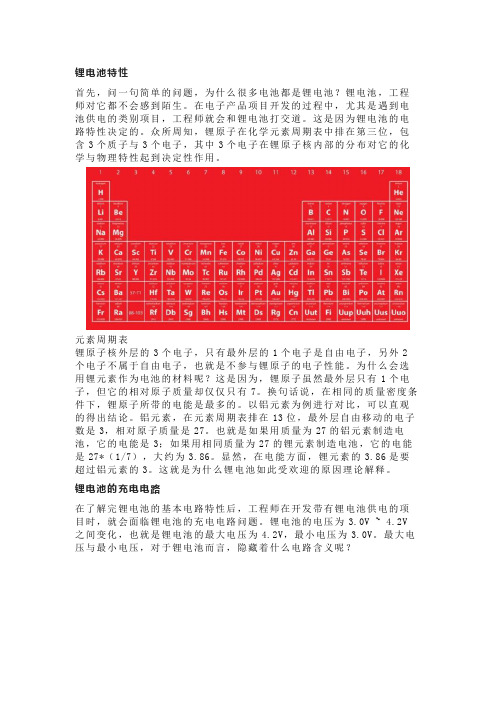
锂电池特性首先,问一句简单的问题,为什么很多电池都是锂电池?锂电池,工程师对它都不会感到陌生。
在电子产品项目开发的过程中,尤其是遇到电池供电的类别项目,工程师就会和锂电池打交道。
这是因为锂电池的电路特性决定的。
众所周知,锂原子在化学元素周期表中排在第三位,包含3个质子与3个电子,其中3个电子在锂原子核内部的分布对它的化学与物理特性起到决定性作用。
元素周期表锂原子核外层的3个电子,只有最外层的1个电子是自由电子,另外2个电子不属于自由电子,也就是不参与锂原子的电子性能。
为什么会选用锂元素作为电池的材料呢?这是因为,锂原子虽然最外层只有1个电子,但它的相对原子质量却仅仅只有7。
换句话说,在相同的质量密度条件下,锂原子所带的电能是最多的。
以铝元素为例进行对比,可以直观的得出结论。
铝元素,在元素周期表排在13位,最外层自由移动的电子数是3,相对原子质量是27。
也就是如果用质量为27的铝元素制造电池,它的电能是3;如果用相同质量为27的锂元素制造电池,它的电能是27*(1/7),大约为3.86。
显然,在电能方面,锂元素的3.86是要超过铝元素的3。
这就是为什么锂电池如此受欢迎的原因理论解释。
锂电池的充电电路在了解完锂电池的基本电路特性后,工程师在开发带有锂电池供电的项目时,就会面临锂电池的充电电路问题。
锂电池的电压为3.0V ~ 4.2V 之间变化,也就是锂电池的最大电压为4.2V,最小电压为3.0V。
最大电压与最小电压,对于锂电池而言,隐藏着什么电路含义呢?单节锂电池最大电压是4.2V,也就是锂电池两端能承受的极限电压不超过4.2V;最小电压为3.0V,也就是锂电池两端的极限放电电压不低于3.0V;换言之,它的另外一层电路意义是锂电池在接收外界的充电电路充电,它的最后充电电压不能高于4.2V;锂电池在向外界负载提供工作电源,它最后消耗的电压会停留在3.0V;基于此,如果工程师将常用的5V/1A或者5V/2A规格的充电器,对锂电池进行直接充电,这样是否可以呢?充电器显然是不行的。
锂电池保护板设计
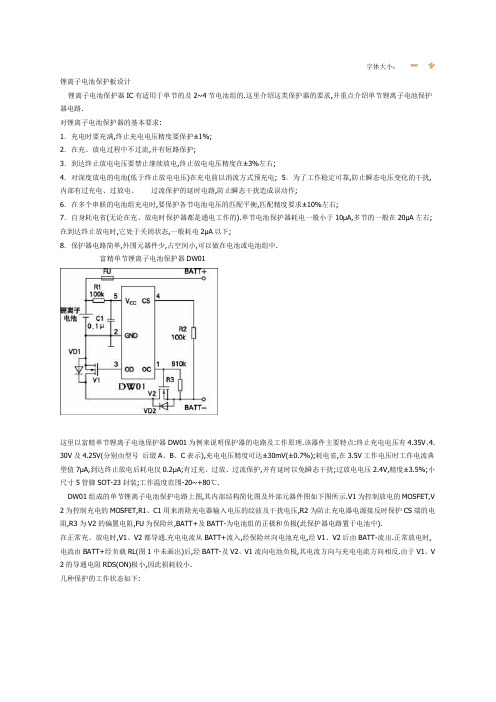
字体大小:锂离子电池保护板设计锂离子电池保护器IC有适用于单节的及2~4节电池组的.这里介绍这类保护器的要求,并重点介绍单节锂离子电池保护器电路.对锂离子电池保护器的基本要求:1.充电时要充满,终止充电电压精度要保护±1%;2.在充、放电过程中不过流,并有短路保护;3.到达终止放电电压要禁止继续放电,终止放电电压精度在±3%左右;4.对深度放电的电池(低于终止放电电压)在充电前以涓流方式预充电; 5.为了工作稳定可靠,防止瞬态电压变化的干扰,内部有过充电、过放电、过流保护的延时电路,防止瞬态干扰造成误动作;6.在多个串联的电池组充电时,要保护各节电池电压的匹配平衡,匹配精度要求±10%左右;7.自身耗电省(无论在充、放电时保护器都是通电工作的).单节电池保护器耗电一般小于10μA,多节的一般在20μA左右;在到达终止放电时,它处于关闭状态,一般耗电2μA以下;8.保护器电路简单,外围元器件少,占空间小,可以做在电池或电池组中.富精单节锂离子电池保护器DW01这里以富精单节锂离子电池保护器DW01为例来说明保护器的电路及工作原理.该器件主要特点:终止充电电压有4.35V、4. 30V及4.25V(分别由型号后缀A、B、C表示),充电电压精度可达±30mV(±0.7%);耗电省,在3.5V工作电压时工作电流典型值7μA,到达终止放电后耗电仅0.2μA;有过充、过放、过流保护,并有延时以免瞬态干扰;过放电电压2.4V,精度±3.5%;小尺寸5管脚SOT-23封装;工作温度范围-20~+80℃.DW01组成的单节锂离子电池保护电路上图,其内部结构简化图及外部元器件图如下图所示.V1为控制放电的MOSFET,V 2为控制充电的MOSFET,R1、C1用来消除充电器输入电压的纹波及干扰电压,R2为防止充电器电源接反时保护CS端的电阻,R3为V2的偏置电阻,FU为保险丝,BATT+及BATT-为电池组的正极和负极(此保护器电路置于电池中).在正常充、放电时,V1、V2都导通.充电电流从BATT+流入,经保险丝向电池充电,经V1、V2后由BATT-流出.正常放电时,电流由BATT+经负载RL(图1中未画出)后,经BATT-及V2、V1流向电池负极,其电流方向与充电电流方向相反.由于V1、V 2的导通电阻RDS(ON)极小,因此损耗较小.几种保护的工作状态如下:1.过充电保护P1为控制过充电的带滞后的比较器,R6、R7组成分压器接在锂离子电池两端,其中间头检测电池的电压并接在R1的同相端,P1的反相端接1.2V基准电压.充电时电池电压低于过充电阈值电压时,P1的反相端电压大于同相端电压,P1输出低电平,使Q1导通,V2的偏置电阻R3有电流流过使V2也导通(V1在充电时是导通的),这样形成充电回路.当充电到达并超过充电阈值电压时,P1同相端电压超过1.2V,P1输出高电平,经100ms延时后使Q1截止,R3无电压使V2截止,充电电路断开,防止过充电.2.过放电保护过放电保护电路是由R4、R5组成的分压器、带滞后的比较器P2、100ms延时电路、或门及由Q2、Q3组成的CMO S输出电路组成.当电池放电达到2.4V时,P2输出高电平,经延时后使OD输出低电平,V1截止,放电回路断开,禁止放电. 3.过流保护以放电电流过流保护为例,CS端为放电电流检测端,它连续地检测放电电流.这是利用CS端的电压VCS与放电电流IL有一定关系,如上图所示.如果把导通的V1、V2看做一个电阻,即RV1DS(ON)及RV2DS(ON),则放电回路如上图的虚线所示.若忽略R2上极小的压降,则VCS对地的电压为:VCS=[RV1DS(ON)+RV2DS(ON)]×IL即VCS与放电电流IL成比例.过流保护电路由比较器P3、延时电路或门等组成.若放电电流超过设定阈值而使VCS超过0.2V,则P3输出高电平,其结果与过放电情况相同使V2截止,禁止放电.该器件尚有其他功能,这里不再介绍.有的电路图将CMOS集成在一片芯片中,电路形式如下:BOM如下:。
锂电3.7v保护板改装电路图

现在国内锂电池,3.7v良莠不齐,在放电电压在2.8v左右基本是极限了,如果到2.5v,好的电池还能充几次。
一般的电池,基本报废。
我买的保护板,有两种芯片(DW01、8205A),DW01取样芯片,8205A功率驱动芯片。
DW01取样:过放电压在2.35v~2.5v,过冲4.0v~4.19v。
要是买了这两个芯片的保护板,国内的锂电池3.7v基本报废,无报废的也充不了几次电。
解决办法:
①头尾并联1N5822( 肖特基二极管),1N5822正向电压0.52v,加上2.35v等于2.87v。
②1N5822串联到B+或B-极上。
③然后将3.7v电池串联在B或+B-上,这时保护板就算在2.35v但实际电池电压在2.87v。
有效保护过放。
说明:电池不能焊在保护板上,如果焊接,电池在充电会有0.52v损失,最好方法就是不焊接,用标准3.7V充电器充电,这样既能电池充满,在使用时又不会过放。
发一张保护板改装电路图。
DW01+锂电池保护电路详解
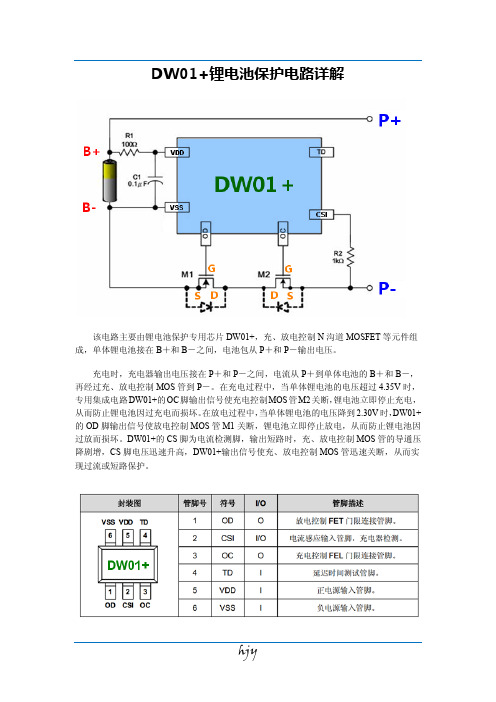
DW01+锂电池保护电路详解
该电路主要由锂电池保护专用芯片DW01+,充、放电控制N沟道MOSFET等元件组成,单体锂电池接在B+和B-之间,电池包从P+和P-输出电压。
充电时,充电器输出电压接在P+和P-之间,电流从P+到单体电池的B+和B-,再经过充、放电控制MOS管到P-。
在充电过程中,当单体锂电池的电压超过4.35V时,专用集成电路DW01+的OC脚输出信号使充电控制MOS管M2关断,锂电池立即停止充电,从而防止锂电池因过充电而损坏。
在放电过程中,当单体锂电池的电压降到2.30V时,DW01+的OD脚输出信号使放电控制MOS管M1关断,锂电池立即停止放电,从而防止锂电池因过放而损坏。
DW01+的CS脚为电流检测脚,输出短路时,充、放电控制MOS管的导通压降剧增,CS脚电压迅速升高,DW01+输出信号使充、放电控制MOS管迅速关断,从而实现过流或短路保护。
hjy。
- 1、下载文档前请自行甄别文档内容的完整性,平台不提供额外的编辑、内容补充、找答案等附加服务。
- 2、"仅部分预览"的文档,不可在线预览部分如存在完整性等问题,可反馈申请退款(可完整预览的文档不适用该条件!)。
- 3、如文档侵犯您的权益,请联系客服反馈,我们会尽快为您处理(人工客服工作时间:9:00-18:30)。
智能型锂电池保护板电路的设计与实现摘要锂离子电池因储能容量大、使用寿命长、清洁环保、能量体积比大等众多优点,所以在各行各业被广泛使用,逐渐成为了电池的主流产品。
然而因锂电池的能量密度高,也使得难以确保其安全性,所以需要相匹配的电池保护电路来确保电池以及使用设备的安全。
本文介绍了通过锂离子电池的充放电特点设计一种支持多种规格锂电池及电池组的保护电路的详细过程。
本文以锂电池的充放电特点作为研究主体,详细阐述了作者在学士学位论文工作期间对锂电池充放电过程中对其保护的研究与设计。
介绍了锂电池的特点以及其保护电路的发展现状及趋势,其次说明了锂电池的充放电的概念、原理、制定目标设计参数以及保护电路的设计过程、实现方法。
设计过程中,首先提出三种可行性方案,并通过理论分析进行方案筛选,确定由精工电子的电源管理芯片S-8209为核心构成的设计方案。
然后通过对S-8209进行Pspice建模并仿真,验证其功能并为设计方案提供理论基础。
然后绘制电路图,并施以改进优化设计方案。
最后进行锂电池保护电路的调试,并对毕业设计期间的工作作出总结。
关键词:锂电池保护电路电池组Pspice建模S-8209The Design and Implementation Of Intelligent Lithium-ion Battery ProtectionCircuitAbstractLithium-ion battery is widely used in almost all walks of life, because of its large capacity, long useful life, environment friendly and large volume ratio of energy. It is becoming the mainstream products of battery. But its high volume ratio of energy is also the unstable caution of security. So it is necessary to match the battery protection circuitry to ensure the safety of the battery and the equipment of using the battery.This article describes the adoption of lithium-ion battery charge and discharge characteristics of a variety of specifications to design a lithium battery group and battery protection circuit.In this paper, the charge and discharge characteristics of lithium battery as a research subject during the process. This article introduces the characteristics of lithium battery and its protection circuit development and trend, followed by shows the principles of lithium battery charge and discharge. And then make the design settings. During the design process, firstly proposed various of design options. Through theoretical analysis to determine the program, selected Seiko electronic power management IC S-8209 to achieve the design. Then carried out on the S-8209 Pspice model and simulation to verify its functionality and provide a theoretical basis for the design. Then draw the circuit diagram, and helping to improve optimization design. Finally, debug the lithium battery protection circuit and summary my work during the graduation project.Keywords: Lithium-ion battery Battery protection circuit Pspice-modeling Lithium-ion battery group S-8209目录1 绪论 (1)1.1 课题研究背景 (1)1.2 课题的研究方向和发展前景 (2)1.2.1锂电池保护电路的现状 (2)1.2.2 锂电池保护电路的发展前景 (3)1.3 选题的目的和意义 (4)1.4 设计要求 (5)1.5 主要工作及流程 (7)2 技术背景及方案选择 (8)2.1 锂电池的介绍 (8)2.1.1 锂电池简介 (8)2.1.2 锂电池的特点 (9)2.1.3 锂电池的充电原理 (11)2.1.4 锂电池的放电原理 (12)2.1.5 锂电池的工作过程 (13)2.1.6 锂电池保护的必要性 (13)2.2 锂电池充电器的介绍 (14)2.2.1 锂电池充电器简介 (14)2.2.2 恒流——恒压式锂电池充电器 (15)2.3 Pspice仿真软件的介绍 (17)2.3.1 Pspice的发展与现状 (17)2.3.2 Pspice的组成 (18)2.3.3 Pspice的分析功能 (19)2.3.4 使用Pspice建立仿真模型 (20)2.4 实现方案的选择 (21)2.4.1 方案介绍 (21)2.4.2 方案的对比与选择 (22)2.4.3 方案存在的问题 (24)3 设计实现 (24)3.1 原理分析 (24)3.1.1 整体实现原理 (24)3.1.2 各部分功能的实现方法 (25)3.1.3 S-8209的性能指标 (27)3.1.4 S-8209功能原理分析 (29)3.1.5 S-8209的典型电路原理 (31)3.2 使用Pspice进行仿真 (34)3.2.1 仿真的意义及作用 (34)3.2.2 对S-8209芯片建立仿真模型 (35)3.2.3 锂电池保护电路的仿真 (37)3.3锂电池保护电路的制作 (41)3.3.1 设计电路 (41)3.3.2 确定选用元件的型号及参数 (42)3.3.3 绘制PCB电路板 (43)4 总结 (45)4.1 实际电路测试 (45)4.2 理论与实际对比分析 (45)4.3 经验总结 (46)致谢 (47)参考文献 (48)附录 (51)附1Pspice仿真描述语句 (51)附2 锂电池保护电路电路图 (52)附3 锂电池保护电路实物图 (54)外文资料翻译及原文 (55)1 绪论1.1 课题研究背景锂离子电池因储能容量大、使用寿命长、清洁环保、能量体积比大等众多优点,所以在各行各业被广泛使用,逐渐成为了电池的主流产品。
然而锂电池的能量密度高,也使得电池的安全性难以得到确保。
锂电池的过度充电(以下简称“过充”)、过度放电(以下简称“过放”)和电池组间的电量不平衡都会导致电池的内部耗损加速,使用寿命减短。
锂电池过充甚至可能造成锂电池爆炸造成人员伤亡和财产损失的事故。
所以需要相匹配的电池保护电路来确保电池以及使用设备的安全。
图1.1 六串锂电池组示意图现在市场上虽然锂电池保护电路很多,但大多都是只能应用于小型锂电池的保护,功能单一且只适用于个别型号的电池,比如手机、相机用的单节锂电池。
在某些需要保护功能全面或是需要同时多节电池充放电的情况下,比如多芯锂电池、动力型锂电池,那些功能单一的保护电路就无法使用了。
对于输出电流、电压值都比较大的动力锂电池磷酸铁锂电池,市场上已有的保护电路并不多。
而关于锂电池组的保护电路则更少了,且这些锂电池组保护电路支持的电池串数较少(一般不多于6串),这就使得其对大型锂电池组的保护力不从心了。
基于此种情况,就需要一种功能全面且基本适用于各种型号及类型的锂电池甚至是锂电池组的保护电路系统。
这种保护电路需要具备过充保护、过放保护、电量平衡保护、过流保护等功能、支持6串以上的电池组使用且可以扩展,根据其扩展性可让电路适用于更多的使用环境。
并且基于这种扩展性可以使此电路作为锂电池保护电路的开发模板,以其为蓝本通过更改参数及更换不同功率的器件设计出同类型的衍生电路。
1.2 课题的研究方向和发展前景1.2.1锂电池保护电路的现状目前市场上已有的各种锂电池保护电路的类型有两种,一种是使用分立元件,另一种是使用专业的电池管理检测芯片。
使用分立元件制作而成的保护电路成本低廉,但是检测精度普遍不高,约在200毫伏左右;分立元件的集成度较低,造成整体电路体积过大;而且分立元件制成的锂电池保护电路考虑到稳定性的问题,一般不带有电量平衡保护部分,这些都使得分立元件的保护电路适用范围减小。
其诸多的缺点使得其、它只能适用于低端产品市场,而对于相对高端的电子产品则很少使用这种类型的保护电路。
图1.2 TSSOP封装图使用专业电池管理IC的话虽然成本偏高一些,但是可以保证较高的精度,精度高的可以达到50mv以下;且集成度高,使用TSSOP或更高等级封装芯片构成的单节保护电路可做到指甲盖大小,其封装大小见图1.2;现在电池充放电管理的芯片在市场占有上基本是精工电子一家独大,占绝大部分市场,其产品功能全面,S-8209、S-8254、S-8211等都具有过放保护、过充保护、电量平衡保护的功能。
1.2.2 锂电池保护电路的发展前景锂电池保护电路未来的发展将以提高侦测电压的精度、降低保护IC的功耗及包装成本、整合MOS、改进误动作防止功能等,同时充电器连接端子的高耐压化也是开发的重点。
对于锂电池保护芯片的封装,目前已由SOT23渐渐的朝向SON,将来还有CSP的封装,甚至COB封装产品的出现,用以满足现在所强调的轻薄短小的需求。
